

Max Davies
2026 Toyota HiAce review
2 Hours Ago
The flagship Mercedes-Benz family SUV offers exactly what you'd expect: luxury, tech, and comfort in an imposing package. Just make sure you've a plus-size garage to store it in.

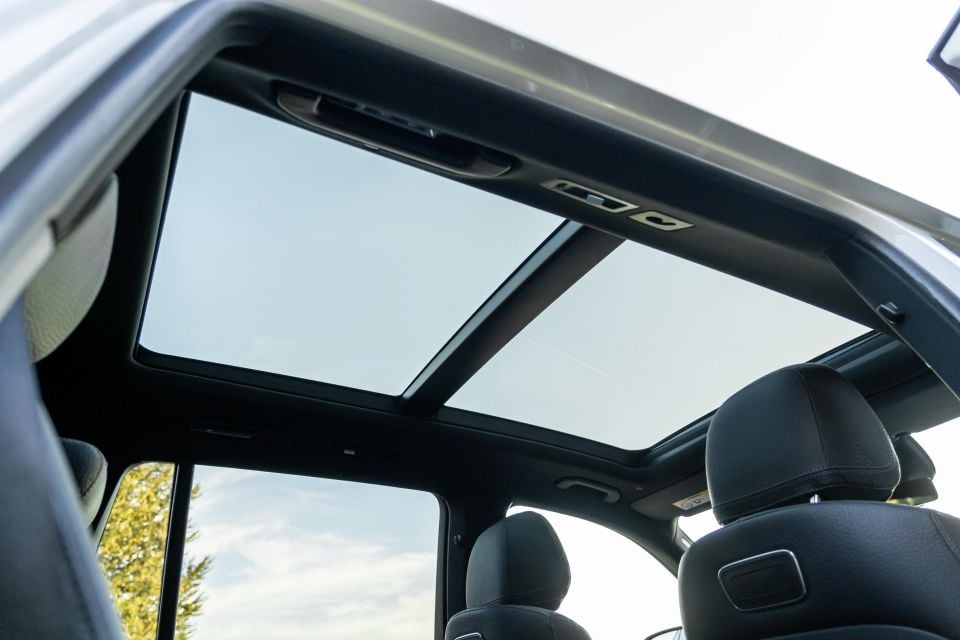

Senior Contributor
New from
$144,600
excl. on-roads

Senior Contributor
New from
$144,600
excl. on-roads


Senior Contributor
New from
$144,600
excl. on-roads

Senior Contributor
New from
$144,600
excl. on-roads
Quickly see how this car stacks up against its competition. Select any benchmark to see more details.
Where expert car reviews meet expert car buying – CarExpert gives you trusted advice, personalised service and real savings on your next new car.
Mercedes-Benz dubs the GLS its “largest and most luxurious SUV”, and “the S-Class of SUVs”. These are bold claims from a pre-eminent luxury carmaker, cause for high expectations.
This 5.2-metre long behemoth is now in its third-generation, and lines up against fellow luxury seven-seaters such as the Audi Q7/SQ7, BMW X7, and Volvo XC90, although we’d bank on Benz trying to conquest some Range Rover aficionados too.
It’s worth noting that the GLS is the longest vehicle of this bunch, and is lengthier even than a Bentley Bentayga. The fact it’s built in the United States and sells best in that market should come as little surprise with this knowledge in mind.
The are currently two versions of the GLS available: the GLS450 petrol ($147,100 before on-road costs) and the GLS400d diesel ($153,900 before on-roads).
That figure includes GST and about $20,000 in Luxury Car Tax, but excludes Stamp Duty, registration, and dealer delivery. Mercedes-Benz Australia’s own pricing calculator for the Melbourne region where this writer lives reveals a drive-away price of $171,825.
How does this compare to key rivals? A BMW X7 xDrive30d can be had for $149,024 drive-away, and an Audi Q7 50 TDI S line for $135,429 drive-away. Perhaps of more interest, the flagship Audi SQ7 version with staggering diesel performance is $183,289 drive-away.
These prices are all based on getting a quote for the Melbourne region at each brand’s website, before haggling.


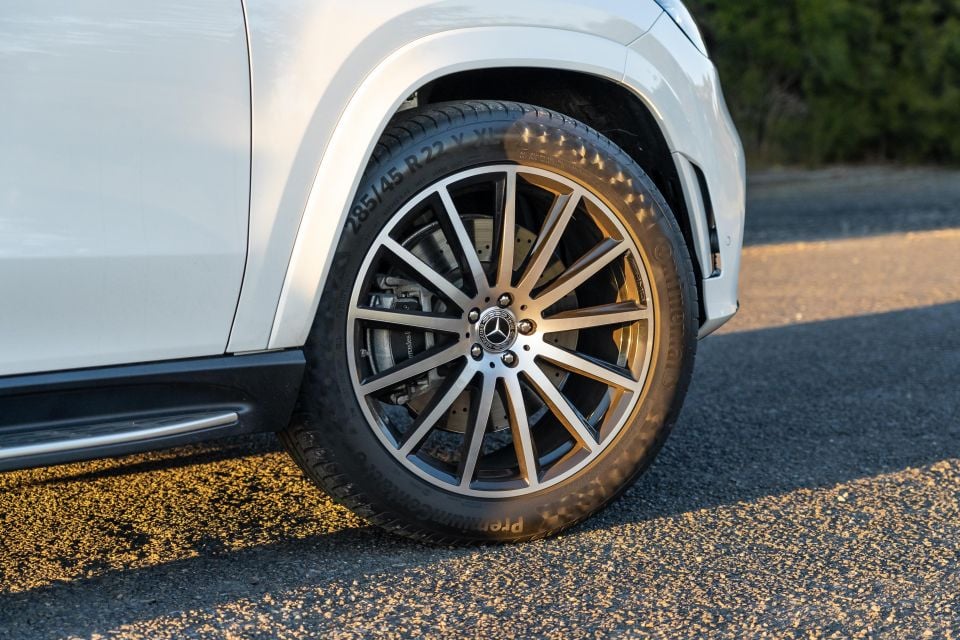
Buy your new car without the stress. It's fast, simple and completely free.

Great service from Travis and team, second time I have used this business would not hesitate to recommend them to anyone
Craig C.
Purchased a Ford Ranger in Sunshine Coast, QLD
CarExpert helped Craig save thousands on his Ford Ranger, now let us save you on your next new car.
Find a dealWhat don’t you get?
Standard exterior features include 21-inch wheels, Airmatic air suspension, aluminium roof rails and running boards, a panoramic glass sunroof, dark privacy glass behind the B-pillar, electric tailgate with hands-free opening, puddle lamps, proximity key, Multibeam LED headlights, power-closing doors, and auto-folding side mirrors.
On the inside you get seven leather/Artico seats (including a front pair with memory, heating and ventilation, and ‘hot stone’ massage functions), velour floor mats, five-zone automatic climate-control, a Nappa leather wheel, chrome and open-pore wood inserts, a head-up display that projects speed and navigation onto the windscreen, and 64 lighting colours.
Multimedia fitted includes a 13-speaker and 590W sound system supplied by Burmester, USB ports for all three rows, two 12.3-inch screens for infotainment and driver instrumentation, AM/FM/DAB+, conversational voice control, satellite navigation with constant map and traffic updates, a vehicle tracker and automated emergency call function, integration with the Mercedes Me Connect app, a wireless phone charger, and Apple CarPlay/Android Auto.
Our test vehicle had two options boxes ticked. The $800 Innovation Package (camera-based gesture-control interface, augmented-reality navigation, and a full-screen map display mode in the driver’s instruments) is a must. The $2500 Night Package (AMG exterior design details, gloss-black accoutrements, 22-inch wheels) is a matter of personal taste.
The list of options is actually quite slim compared to some competitor vehicles, though there are two things that cost extra which frankly ought to be standard: the $1300 electric sun blinds for each back door, and the $850 tyre-pressure monitoring system.
Passive standard safety features include nine airbags, and ISOFIX/top-tether child seat anchor points in the second and third rows.
The list of active safety assist features is as extensive as you’d expect. There’s a collision-alert and autonomous emergency braking, active cruise control with stop-and-go, lane-keeping alert and steering aid, Evasive Steering Assist, a traffic-sign-identifying camera, an obstacle warning exit system, blind-spot monitoring, rear cross-traffic alert, route-based speed adaptation, and an active parking aid with a 360-degree camera.
There’s also a ‘Pre-Safe’ system that initiates belt tensioning when an imminent potential impact is detected, works to reduce potential hearing damage upon impact by triggering the stapedius reflex through the sound system just before the bang of impact, and triggers air chambers in the front-seat side bolsters to nudge occupants away from the impact site.
Despite this plethora of safety functions, there’s actually no Euro NCAP or ANCAP crash-test result for the big GLS. So, while Mercedes-Benz’s track record at acing these tests is undeniable, we don’t know for sure how its biggest SUV goes at handling an accident.
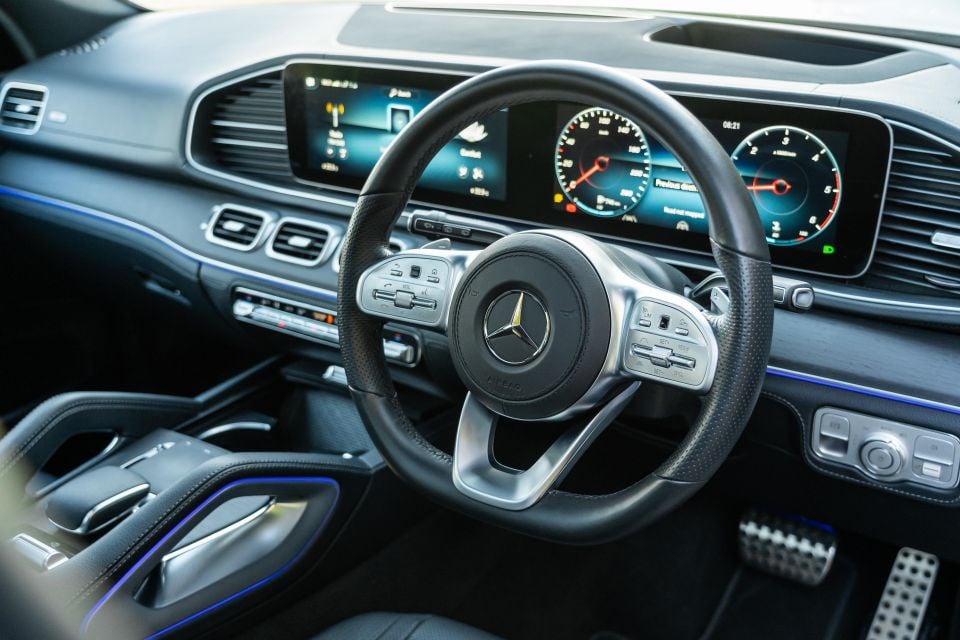
The front seats are trimmed quite rugged-grain leather that reminds this reviewer of a Volvo. But it’s hard to criticise the comfort and support on offer. Distinctive brand features include electric seat adjustment buttons on the upper-doors, and the two grab handles running along the centre (transmission) tunnel.
Once seated, you’re greeted by a beautifully-finished wheel with perforated hand grips and good quality buttons and trackpads on each spoke, behind which sit largely extraneous paddle shifters, and column-mounted stalks for the transmission (careful not to tip the car into neutral when you think you’re reaching for the indicator), and wipers/blinkers.
Lashings of silver trims, open-pore wood, white stitchwork, plush carpet, and ambient light piping enliven things, as do the projecting puddle lights, massive glass sunroof, and the dark headlining surrounding it.
It’s all very nice and glamorous, though there seemed to be a few mostly out-of-sight trims and the odd detail that felt a little beneath the standard of an S-Class limo. Notice in the gallery the mis-aligned stitching where the glovebox meets the leather centre-fascia surround. Sometimes it’s the little things.
The switches and buttons adorning the fascia and centre tunnel seemed fairly straightforward to adjust to. There are button-based infotainment shortcuts, and a large rocker just ahead of the centre-split console to raise or lower the air suspension.
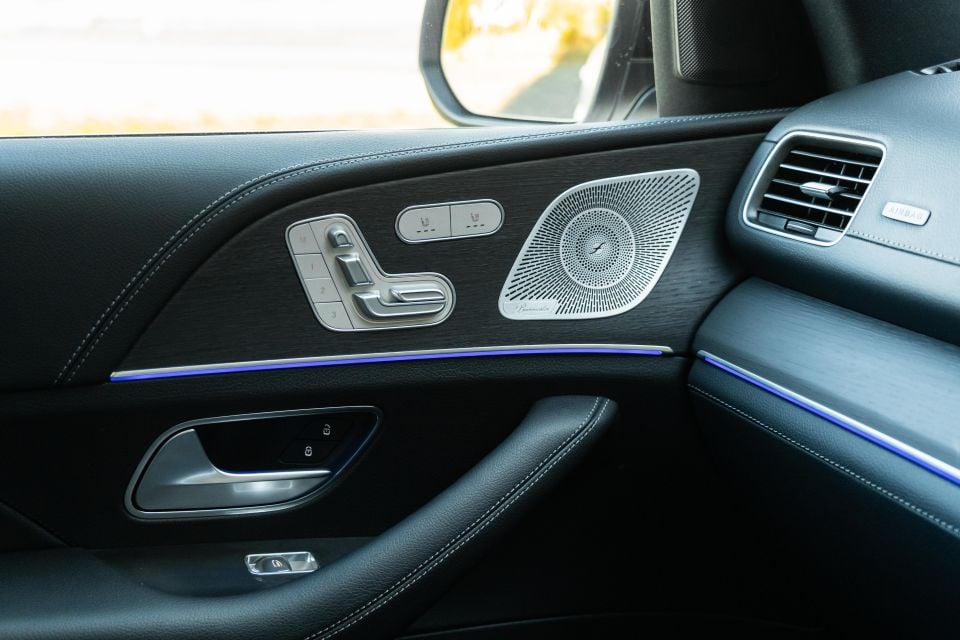
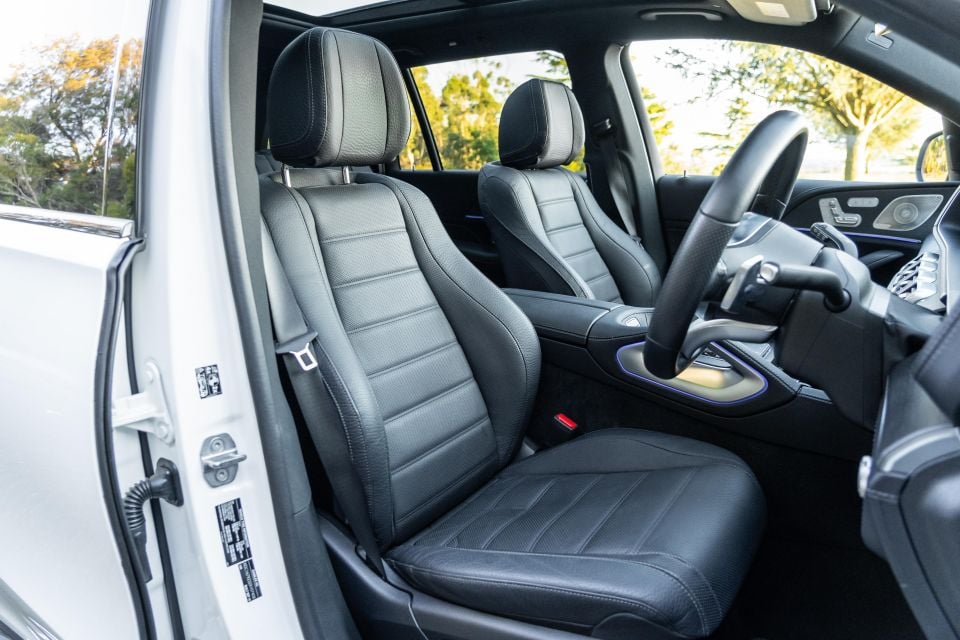
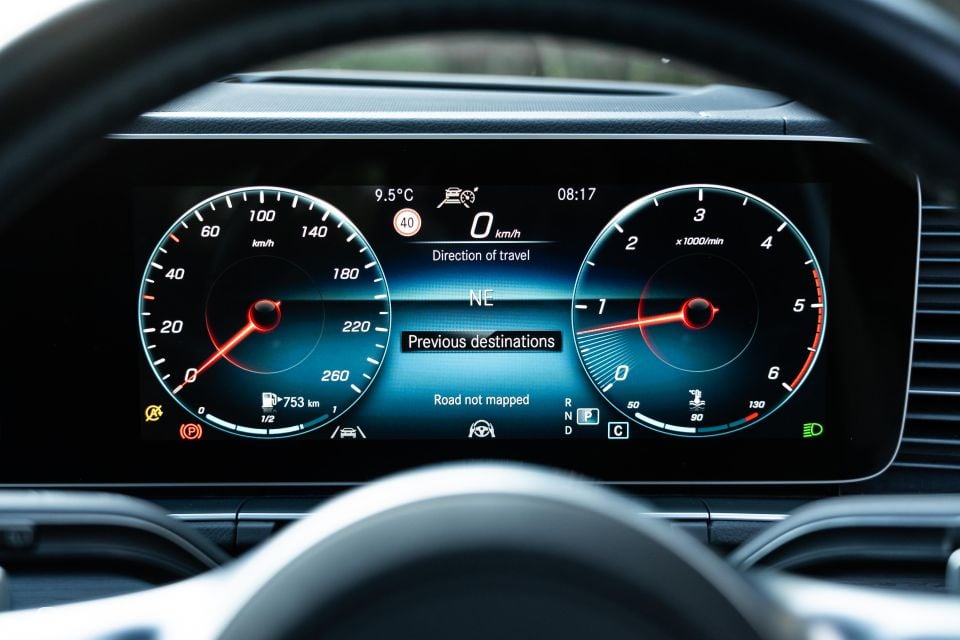
The driver’s instrument display is fantastically versatile, housing myriad digital designs to scroll through and showing copious driving, audio, and navigation data with subtle thumb-scrolling of the right-side steering wheel spoke’s trackpad. This is all abetted by the huge HUD showing speed, road data, directions, and audio information.
The centre screen runs Mercedes’ MBUX system that can be interfaced with via touch or the trackpad, but also works using conversational voice control. If you say “Hey Mercedes, I’m cold” it’ll respond by pumping up the heater.
One additional option ($3900) is called the Energizing Package Plus that heats front and rear armrests and the outer seats in the middle row, ‘program-specific lighting moods’, temperature-controlled cupholders, and the Air Balance system that pipes fragrances through the interior ventilation, parallel to the onboard audible wellness coach.
The second row’s outboard seats are designed for anyone up to 200cm tall, while the middle seat has a shorter base. I’m nearly that tall and had room to spare in both outboard seats.
Amenities include electric seat adjustment buttons on the doors, damped grab handles, LED lights, air vents in the roof and the back of the centre console, a digitised temperate adjustment panel, and USB-C charge points.
The backs of each front seat are trimmed in hard-wearing plastic, and each has flimsy netting for storage, and clipping points for tablet-holders. The material and carpet quality in the rear feels as high-standard as the front.
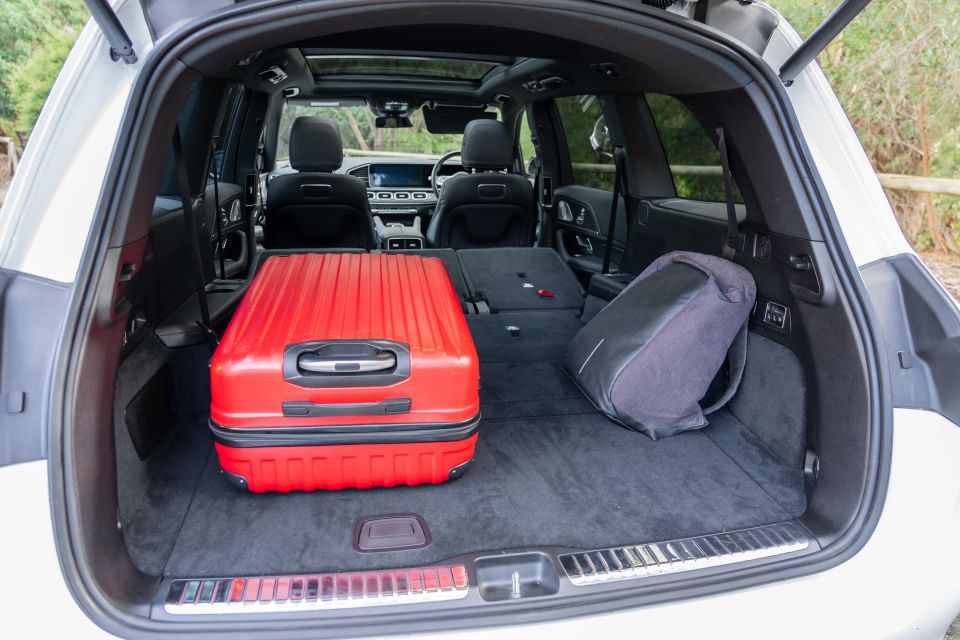
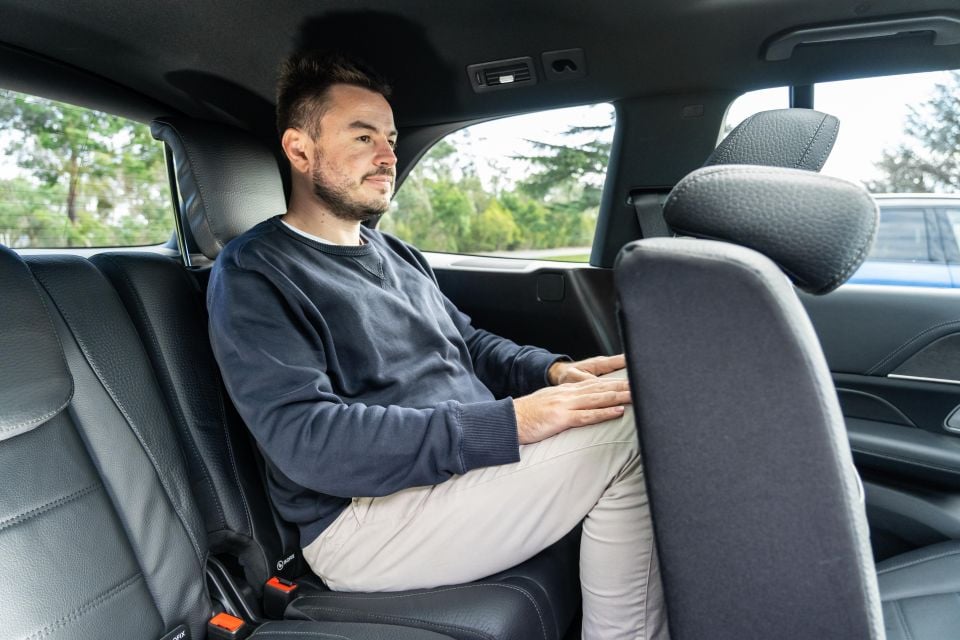
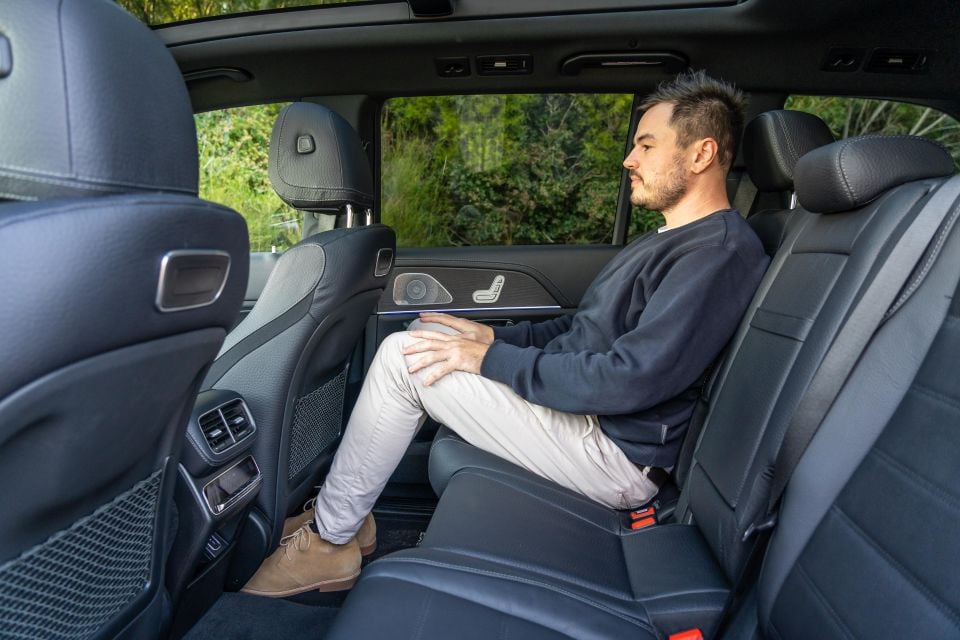
Access to the third row is made easier by electric button-operated seat adjustment for the middle, split-fold bench. No physical exertion required. Rearmost occupants have their own vents and USBs. Mercedes-Benz claims anyone under 194cm can fit, though I’d not be volunteering myself for long journeys.
Still, it’s no mere ‘5+2’ seater, as my colleague Paul (about 180cm) demonstrates in the images.
Even with all three seat rows in use, there’s still a generous 355L of storage (more than a Mazda CX-30 offers), despite the collapsible spare wheel (temporary use only) under the floor.
With the rearmost pair of seats folded away into the floor (electrically of course) this rises to 890L, and with the middle row also folded this figure grows to 1470L. These numbers are all measurements to the top of each seat, not the roof.
With just the front two seats in use, the loading floor is more than 2.2 metres long, meaning two adults can easily sleep there. Or, more likely, the weekend Ikea run will be handled with ease.
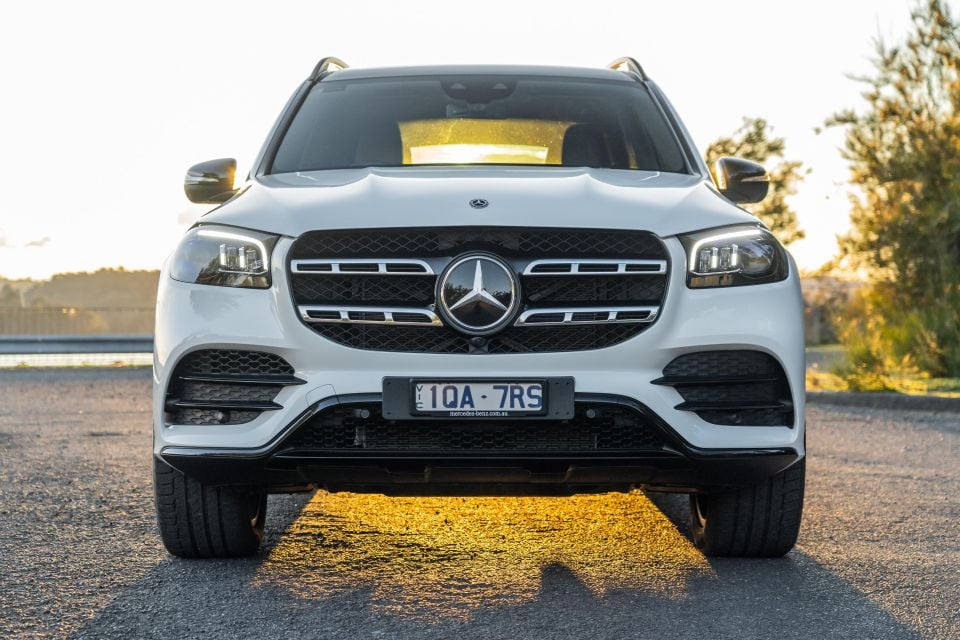

The GLS400d weighs a hefty 2.7 tonnes, making it as heavy as a larger-than-average White Rhino or nearly 400kg more than a full-size Range Rover Vogue.
However, power is not a problem. Its inline-six diesel has a 2.9-litre displacement and produces 243kW of power at 3600rpm, and a meaty 700Nm of torque between 1200 and 3200rpm.
It’s mated to a nine-speed automatic transmission controlled by a column-mounted stalk, and permanent torque-on-demand all-wheel drive (AWD) system.
Top speed is 238km/h, the zero to 100km/h sprint capability is a swift 6.3 seconds, and the maximum braked-trailer towing capacity is 3.5-tonnes with a 280kg downball rating.
Diesel economy on the combined-cycle is 7.7 litres per 100km, while in urban driving the claim is 9.3L/100km and in extra-urban highway driving it’s 6.7L/100km. The tank is 90L, meaning a theoretical driving range nearing 1200kg.
On my drive loop I averaged 10.3L/100km – respectable for any vehicle this large, but not in line with the claim.
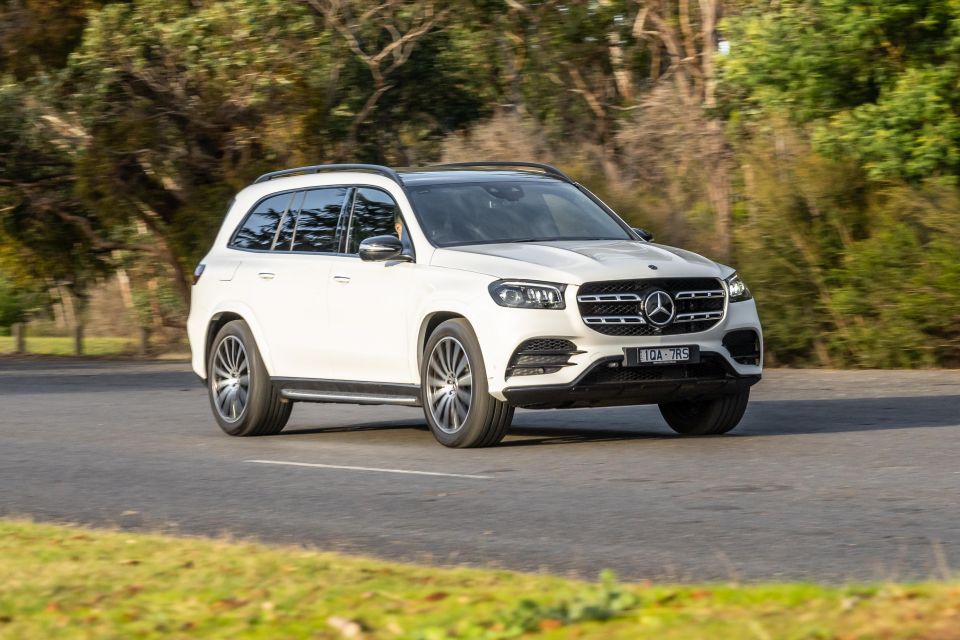
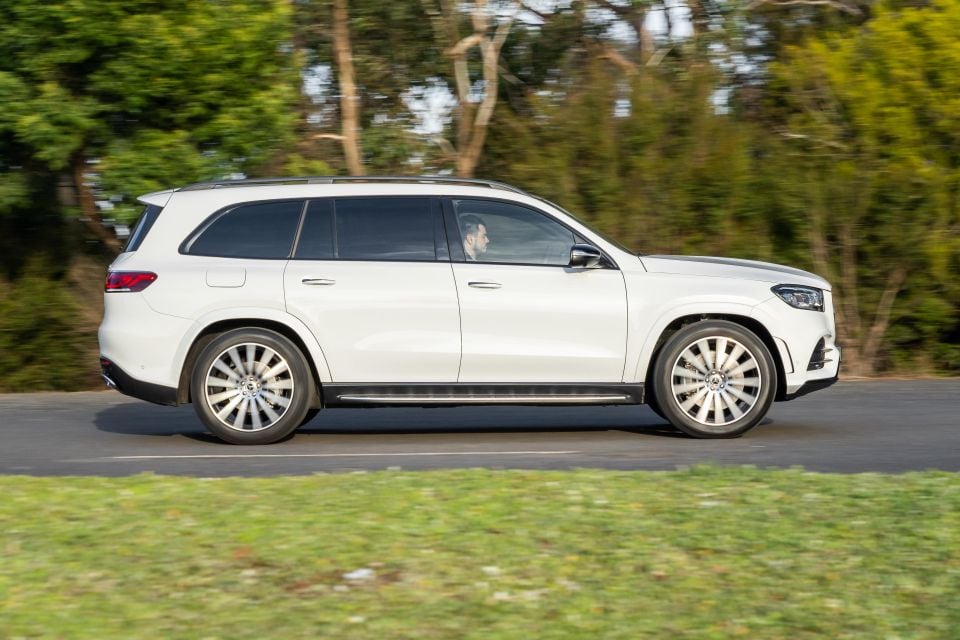
The engine is well insulated at idle, with very few rattles or vibrations escaping beyond the confines of the bonnet. And the idle-stop system is commendably smooth.
It’s also effortless, with peak torque on tap almost from idle ensuring there’s seemingly always some pulling power held in reserve. The tall ninth ratio also means highway cruising is effortless, with the engine ticking over at 1500rpm at 110km/h.
A rocker switch takes you through various driving modes, with the sporty setting telling the transmission to hold lower ratios longer. This car is ideally suited to comfort mode though, in which the transmission chooses a tall gear and the car simply lopes along.
The suspension layout is double-wishbone front and multi-link rear, with active damping that can stiffen or soften according to the selected driving mode, and ‘Airmatic’ air suspension in place of traditional steel springs.
It rides about as smoothly as any car with 22-inch wheels with front and rear aspect ratios of 45 and 40 respectively could be expected to. At high speeds or over pockmarked B-roads, urban corrugations and ungraded gravel, the GLS felt largely composed and comfortable.
There was the occasional hint of ‘sharpness’, presumably from the lack of rubber sidewall, over specific low-speed ruts, which we suspect could in part be mitigated by opting for smaller alloys. But compared to the smaller GLE on steel springs, the GLS is a magic carpet.
The steering is deliberately programmed to be light (though it gains resistance in sports mode) and largely free of feel, though without rear-wheel movement the turning circle is hardly tight. For such a big car, it actually stays quite flat through corners, and the AWD system seemed quick to send torque where it was needed.
The active safety systems worked well, with the most useful in my time with the car being the highway pilot that can steer the GLS through moderate highway bends, and speed-match with the vehicle ahead. That said, the dimensions mean you’re always glad for the blind-spot warning lights too.
One feature I must point out is the optional ‘augmented reality video’ navigation feature. When you’re navigating somewhere, it replaces the map with live forward-camera footage and an overlaid, dynamic blue directional arrow that points you where to go. At challenging junctions and roundabouts, it’s super helpful.
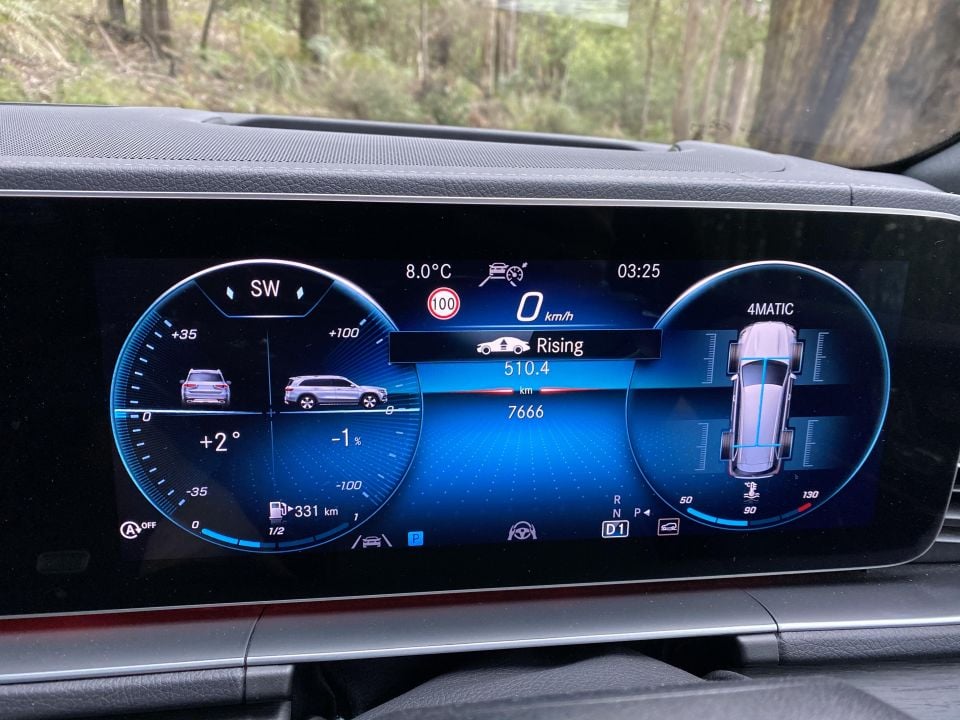
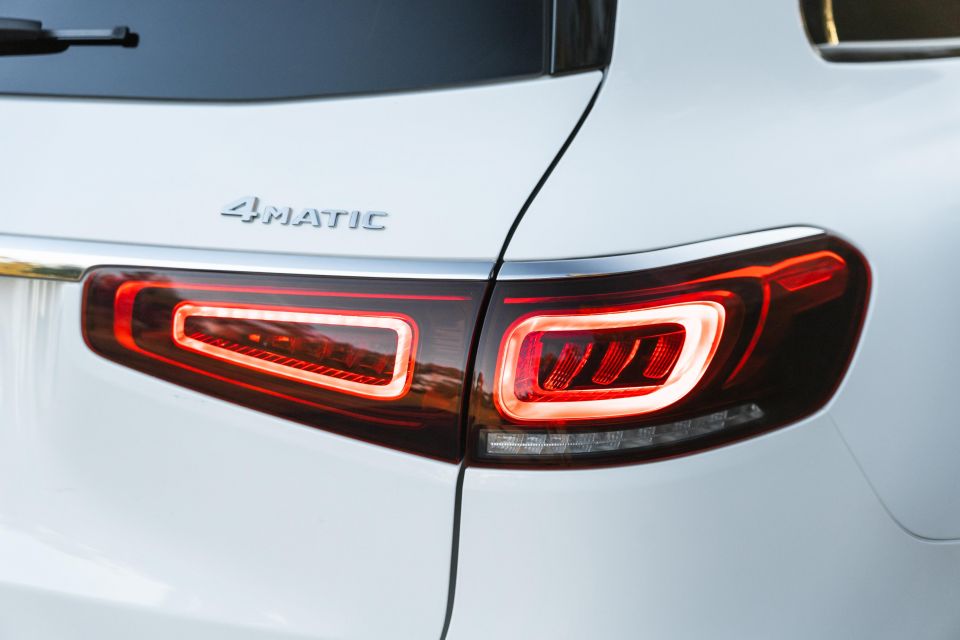
Between the vast list of active safety features and the handling dynamics – never nimble, but also never unwieldy – the Mercedes-Benz GLS isn’t too difficult to drive. But at more than 2.0 metres wide and 5.2m long, tight urban roads or driveways might be overkill. Heck, it barely fit in my two-car garage, though perhaps the average owner has somewhere more expansive…
One noteworthy feature not fitted to our test car is the optional E-Active Body Control system pinched from the S-Class that uses camera data to ‘read’ the road ahead and change the damping and air suspension level at each corner to suit. It’s $13,000, so would want to be good! Imagine the bragging rights…
The vast majority of GLS buyers are likely to spend most of their time in leafy suburb, beach houses and snowy chalets. But for those who wish to go further from the beaten path, a $3500 Off-Road Engineering package (in lieu of the Night Package) is available.
It adds full 0-100 per cent axle locking front-rear, underbody protection, off-road traction programs, a low-range-mimicking off-road gearbox setting, a centre display panel showing all manner of off-road data, and downhill speed regulation software. I doubt it’s ever quite a Range Rover.


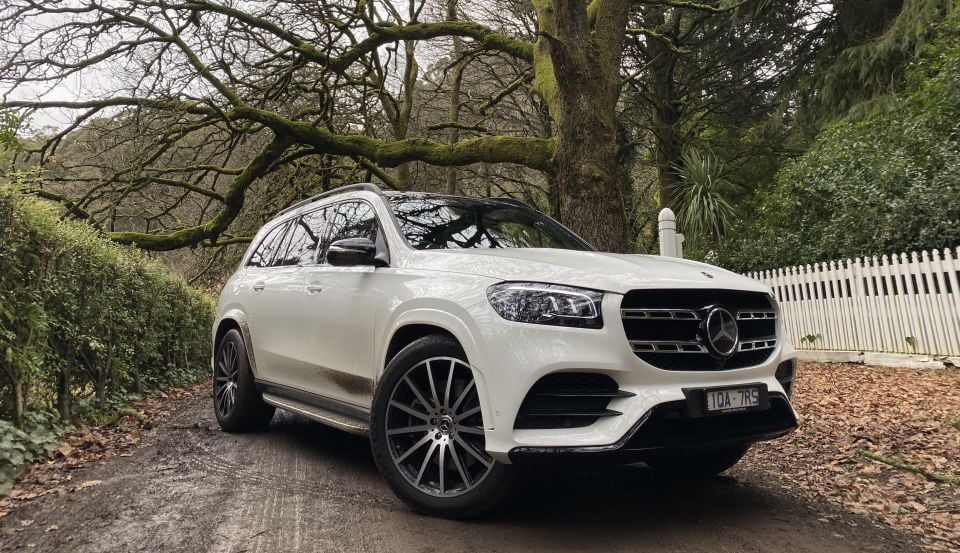
Unlike some premium competitors, Mercedes-Benz Australia offers a five-year, unlimited-kilometre warranty on all of its passenger vehicles.
You can pay for servicing as you go, but you’ll save $600 if you purchase the $2700 maintenance plan that covers the first three services. The intervals are quite long: either 12 months or 25,000km, whichever comes first.
If you want to pay in advance for five services (covering either five years or 125,000km) the current cost is listed as $5200.

As the longest luxury SUV this side of a Rolls-Royce Cullinan, it’s safe to say this Mercedes-Benz GLS400d is probably more car than most of its prospective buyers really need. But that translates into a cabin as capacious as all but the biggest families will require.
I think if we lived in a parallel dimension and I became a prospective buyer of something like this, the smaller and punchier 900Nm (!) Audi SQ7 would be my pick, and there’s no doubt that this GLS’s price point will drive away a few tyre-kickers.
Yet the GLS’s cabin luxury, modern technology, driver-assist functions, potent drivetrain, and overall sense of serenity ensure it largely lives up to its billing as the head of Benz’s SUV range. Very fit-for-purpose, if your purpose is carting a big family in sublime comfort.
Where expert car reviews meet expert car buying – CarExpert gives you trusted advice, personalised service and real savings on your next new car.


Max Davies
2 Hours Ago


William Stopford
18 Hours Ago


Ben Zachariah
19 Hours Ago


Derek Fung
20 Hours Ago


Matt Campbell
1 Day Ago


William Stopford
2 Days Ago